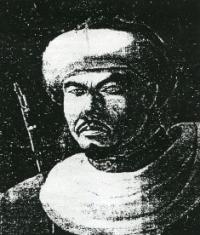You are here
Keiki Batyr (1871 - 1922).

Photo tours to Kostanay region.
"A feat for our people is not a sacrifice, but one of its daily manifestations"
Vera Panova, "Sputniki".
Tours on jeeps from Kostanay to Arkalyk.
Keiki (Nurmagambeta) Kokembayuly was born in 1871 in the Baytum area of the Kostanay region and came from the Kipchak clan of the Middle Zhuz. It was only with the advent of independence and glasnost that new names of the heroes of resistance were named - the leaders of the movement and ordinary participants who gave their lives for the liberation of the Kazakh people - to pronounce aloud the name of Keiki batyr in different regions.
And all because he was brutally killed by the Red Army. As history shows, Keiki Batyr was an associate of Khan Abdigapar and wholeheartedly supported his ideas about the unity and independence of the Kazakh people.
He was an intelligent, shrewd and authoritative person. His army, if not very large, won qualitatively. The detachments were trained in formation and rifle techniques. Simultaneously with the improvement of the army, Abdigapar was engaged in the organization of civil strengthening.
First of all, his power was not one-man. He renounced the title of khan and accepted the title of emir as a sign that he wanted to rule not autocratic, but with the help of the people, represented by their representatives.
Under him there was a council of 20 people elected by volosts. Thus, all power passed to the local population in the person of freely elected members of the Emir's council. The taxes went to the maintenance of the administration and the national army.
The army was commanded by Amangeldy Imanov. His best friend was Keiki batyr - a talented leader in a unit of thousanders during the national liberation movement. He was a participant in the 1916 Torgai uprising.
Distinguished himself in the Dogalsky battle, in the battle on the Kuyik area, in the blockade of the town of Torgai. The Batyr did not recognize the revolution of Keiki and was wary of the Soviet power. But since he was reputed to be a brave and intelligent man, he did not hesitate to express his opinion.
Therefore, the authorities disliked him. After the death of Amangeldy on May 18, 1919 and the death of Khan Abdigapar Keiki, the batyr was forced to leave for Ulytau and Kyzylkum. And on April 22, 1923, he was brutally killed by soldiers of the Red Army.
Apparently, as proof that the trial of the batyr was accomplished, the killers decapitated the body, cut off both hands and took away with them, and left the remains lying next to the bodies of the batyr's murdered relatives - his wife, who had not had time to give birth to a child, and his brother.
Frightened by the atrocities, the locals fled to the steppe without burying the dead. Who and in what place betrayed them to the earth is still unknown. For a long time it was generally forbidden to talk about Keiki Batyr.
Nevertheless, in recent years, many books, stories, poems and documentary stories have been written about his exploits, courage and striving to make his people happy and independent. In honor of the 125th anniversary of his birth, a bust was erected to him in Arkalyk, and in his homeland in the settlement of Amangeldy a bust was held.
The fellow countrymen were glad that finally everything was put in its place and Keiki batyr was now on a par with the historical figures of the region. Only one thing upset: that the national hero does not have a grave.
Meanwhile, thanks to the efforts of the well-known historian in the republic Manash Kozybayev, it became known that in 1926, in connection with the move of the capital of Kazakhstan from Orenburg to Kzyl-Ordu, the skull of the leader of the Kulan-Kipchak tribe Keiki batyr was transferred to the Kunstkamera of Leningrad (St. Petersburg).
This was confirmed by the official response to the inquiry of Professor M. Kozybayev and the Embassy of the Republic of Kazakhstan in Moscow in January 1885 from the Ministry of Foreign Affairs of the Russian Federation.
It says that "the transfer of the skull of Keiki Kokembayuly can be considered by the Russian side if a request comes from close relatives (descendants) intending to give the remains to burial." The work on the transfer of the batyr's skull to the historical homeland was not limited to this.
Of course, his few relatives sent their request to Russia. Historians also showed interest. At the official level, in September 1996, the akim of the Torgai region V. Barykin addressed the Deputy Prime Minister of the Russian Federation with a letter:
“In connection with the upcoming events dedicated to the 80th anniversary of the national liberation movement, I ask you to assist in transferring Keiki Kokembayuly's skull to his relatives, for the betrayal of the earth according to the national custom of the Kazakhs...".
At the formal level, the issue was resolved. And for this, thanks to the batyr's relatives, scientists-historians, fellow-journalists. It was about the money needed for this event. The relatives of Keiki-batyr are not so rich as to bear all the expenses for the transfer of the skull and its burial in the village of Amangeldy, where it is planned to build the Keiki batyr mausoleum.
The founders of the foundation and its first sponsors turned to their fellow countrymen with a request to provide financial support, which will be perceived as a tribute to the memory of the great son of Torgayschina.
To date, the remains of Keika batyr are kept in the anthropological fund in the Kunstkamera of St. Petersburg.
Authority:
http://www.tarih-begalinka.kz/ru/history/modern/figures/keiko/







